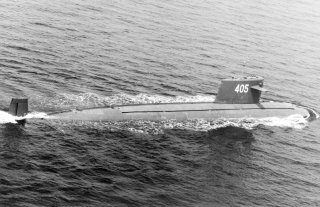The U.S. Navy Wanted to Know Everything About This Submarine
The Type 091 was the first Chinese-made submarine to incorporate the much more hydrodynamic teardrop hull shape.
Here's What You Need to Remember: Though the Type 091 has limited capabilities when compared to contemporary nuclear-powered submarines, it represents China’s first step into nuclear propulsion.
Mao Zedong famously declared that China “will have to build nuclear submarines even if it takes us 10,000 years.” Though it took significantly less time than that, their first nuclear submarine, the Type 091, has some drawbacks.
Type 091-class
The Type 091-class, (also known as the Han-class) entered Chinese service in 1974. Although it is sometimes used as an example of “Chinese engineering incompetence,” the Han-class is perhaps not so, considering the state of the Chinese defense industry, economy, and political atmosphere in the 1970s.
Chinese submarine design has historically been focused on developments within the United States Navy, and the type 091 is no exception. Despite internal anti-western sentiment in China thanks to the destructive Cultural Revolution, Chinese submarine designers coopted some American design principles.
The Type 091 was the first Chinese-made submarine to incorporate the much more hydrodynamic teardrop hull shape. This design is optimized for underwater propulsion, rather than surface sailing, which favors a more boat-like hull shape. The teardrop hull shape had been standard in the United States Navy since the USS Albacore’s launch in 1953.
It has six 533 millimeter torpedo tubes and can additionally launch anti-ship cruise missiles from its torpedo tubes, though their utility is limited, as the Type 091 may only be able to fire missiles while stationary. The Han-class also has a crew complement of 75.
These submarines are considered loud, and therefore an easy target to track. To reduce their noise signature, the class was outfitted with anechoic tiles, which are essentially rubberized tiles that adhere to the submarine’s hull. These tiles are impregnated with air bubbles of varying diameter that are optimized to absorb enemy sonar at varying depths, in order to minimize a return signal, or ping. Despite this, the Han-class’ present battlefield effectiveness is questionable.
Ishigaki Incident
In 2004, a Han-class submarine entered Japanese territorial waters. While submerged, the Type 091 swam near Ishigaki Island, one of Japan’s southernmost islands and just 200 miles east of Taiwan—an overall politically complex area. After the submarine continued northward, the Japanese Maritime Self-Defense Forces were put on high alert for only the second time since World War II.
After initially tracking the Han-class submarine with passive sonar, the JMSDF began using active sonar, which alerts the sub it is being tracked, and is widely seen by sailors as a warning signal. Anti-submarine warfare ships and helicopters were deployed to track the Type 091 as it exited Japanese territorial waters. Though China initially denied the sub was theirs, they later issued an apology for the intrusion into Japanese waters.
Baby Steps
Though the Type 091 has limited capabilities when compared to contemporary nuclear-powered submarines, it represents China’s first step into nuclear propulsion. As such, and considering the host of difficult economic and political factors in 1970s China, it is rather remarkable that the Type 091 ever even came to be.
Caleb Larson holds a Master of Public Policy degree from the Willy Brandt School of Public Policy. He lives in Berlin and writes on U.S. and Russian foreign and defense policy, German politics, and culture. This article is being republished due to reader interest.
Image: Wikipedia

